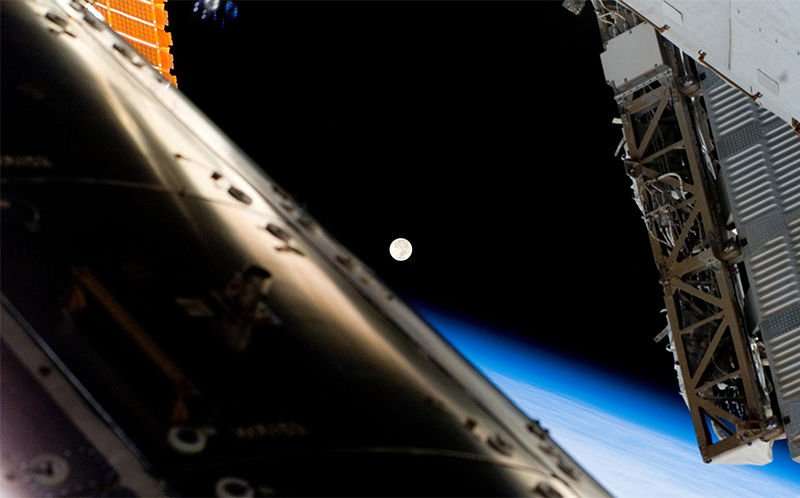The moon seen from the International Space Station.Credit: NASA
As the world’s leading spacefaring nations plan for their next big outpost in space — a successor to the International Space Station — scientists are drafting a wish list of experiments for the most remote human laboratory ever built. NASA and the European Space Agency (ESA) are hosting meetings to discuss the science plans, the first of which are taking place on 5–6 December in Noordwijk, the Netherlands.
No nation has yet committed to fully funding the project, which does not yet have an estimated cost but is slated for the 2020s. But the space agencies are working on a plan to build an outpost in orbit around the Moon. Scientists are already jockeying for room on the platform. “I have been taken aback by the extent and the quality of proposals,” says James Carpenter, human and robotic exploration strategy officer at ESA in Noordwijk, who organized the event and had to double the capacity of the agency's event to 250 people, owing to the level of interest.
Known as the Deep Space Gateway, the platform is the “commonly accepted” next step once the International Space Station retires in the mid-2020s, says David Parker, director of human spaceflight and robotic exploration at ESA. The space agencies have made clear that its main purpose would be to test, from Earth’s backyard, the technology for deep-space exploration and long-duration missions — including, eventually, going to Mars. “But we also want to work out how we get the best science out of it,” says Parker.
Scientists are eager to have input at the earliest stages in the planning process. Doing so could help the project to avoid the fate of the International Space Station, which some have criticized for being slow to live up to its research potential. But researchers should remember that the main purpose of both facilities is to support future exploration, says Richard Binzel, a planetary scientist at the Massachusetts Institute of Technology in Cambridge. “The space station is an instrument for human experience and, almost, space diplomacy,” he says. “Where scientists get sniffy is in the claim that the science justifies the space station — it does not and it never has.”
Still, researchers have already devised a vast array of experiments. The platform’s location — outside Earth’s protective magnetic field and so representative of deep space, and with ready access to the Moon — would provide a unique environment for research. As well as testing how space affects human physiology and technology for survival, researchers will propose ways in which the station could support planetary studies and allow for innovative physics and astronomy experiments, says Carpenter.
The workshop will showcase a host of physics experiments that would not only exploit the environment, but might also become economically viable only by piggybacking off the station’s power and navigation capabilities. These include a meteoroid-environment monitor, which would study the drifting interstellar dust that never reaches Earth owing to the planet's magnetic field. A low-frequency radio observatory could be used to pick up radiation from the Universe’s ‘dark ages’, between 400,000 and 100 million years after the Big Bang — which is hugely challenging on Earth because of interference from human sources and the planet’s ionosphere, says Mark Bentum, a physicist at the University of Twente in Enschede, the Netherlands.
A space station in the vicinity of the Moon would afford lunar scientists regular access to its surface, says Mahesh Anand, a planetary scientist at the Open University in Milton Keynes, UK. Water has been confirmed on the Moon in the past decade, but researchers still know little about where it is, how much there is and how feasible it would be to extract. Researchers aboard an orbiting laboratory would also be able to control lunar rovers in real time, and could study moon rock without having to return samples to Earth.
Others are seeking to develop technology for deep-space travel. Armin Gölzhäuser, a physical chemist at Bielefeld University in Germany, wants to test the potential of nanometre-thick carbon membranes, made from fused aromatic molecules, for use as long-lasting, thin and efficient filters that could recycle wastewater or air. Meanwhile, biochemist Katharina Brinkert at the California Institute of Technology in Pasadena and her colleagues have designed a device to boost the solar-assisted production of hydrogen and oxygen, optimized for use in microgravity.
Political interest in the platform is growing. In September, NASA signed a joint agreement with Roscosmos, its Russian counterpart, which outlined such a platform as part of their “common vision for human exploration”. The Japanese and Canadian space agencies have also expressed interest. Both NASA and ESA have already contracted industry partners to undertake preliminary work. But if and when the project moves forward will depend largely on NASA’s new administrator. James Bridenstine, a Republican member of the US Congress from Oklahoma, has been nominated for the role but has yet to be appointed. If the Deep Space Gateway is to launch as planned in the mid-2020s, key decisions need to be made by the end of 2019, says Parker.

HST87 on December 6th, 2017 at 15:24 UTC »
This is some sci-fi stuff with them having to clearify James is, indeed, human.
StompChompGreen on December 6th, 2017 at 15:15 UTC »
makes it sound like a bunch of teenagers are assembling a new station and the scientists think its not fair.
what kind of title is this?
klaxxxon on December 6th, 2017 at 14:22 UTC »
The start is good, "Deep Space Gateway" is a fittingly cool name.